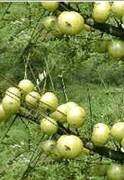
Amalaki

Common Names
About  Taxonomy
Taxonomy
 to access the GRIN database record about the specific taxonomical hierarchy (Family, Genus etc.).
to access the GRIN database record about the specific taxonomical hierarchy (Family, Genus etc.).CLASSIFICATION
OTHER FAMILY:
CLASSIFICATION
SPECIES
Plant Description
Trees 3-8(-23) m tall, to 50 cm d.b.h., monoecious, deciduous; bark brownish; main stems terete, sparsely lenticellate, with very reduced short shoots producing groups of leafy shoots; leafy shoots angular, tawny pubescent, at start of growing season often with poorly developed leaves and densely flowered, later with fewer flowers and better-developed leaves. Leaves distichous; stipules triangular-ovate, 0.8-1.5 mm, brown, margins entire or denticulate, ciliate; petiole 0.3-0.7 mm; leaf blade oblong or linear-oblong, 8-23 × 1.5-6 mm, papery to leathery, paler abaxially, green adaxially, drying reddish or brownish, base shallowly cordate and slightly oblique, margin narrowly revolute, apex truncate, rounded or obtuse, mucronate or retuse at tip; lateral veins 4-7 pairs. Fascicles with many male flowers and sometimes 1 or 2 larger female flowers. Male flowers: pedicels 1-2.5 mm; sepals 6, membranous, yellow, obovate or spatulate, subequal, 1.2-2.5 × 0.5-1 mm, apex obtuse or rounded, margin entire or shallowly denticulate; disk glands 6, subtriangular; stamens 3; filaments coherent into column, 0.3-0.7 mm; anthers erect, oblong, 0.5-0.9 mm, longitudinally dehiscent, apex mucronate. Female flowers: pedicels ca. 0.5 mm; sepals 6, oblong or spatulate, 1.6-2.5 × 0.7-1.3 mm, apex obtuse or rounded, thicker, margin membranous, ± lobate; ovary ovoid, ca. 1.5 mm, 3-celled; styles 3, (1-)2.5-4 mm, connate at base, deeply bifid, lobes divided at tip. Fruit a drupe, globose, 1-1.3 cm in diam., exocarp fleshy, pale green or yellowish white, endocarp crustaceous. Seeds reddish, 5-6 × 2-3 mm. Fl. Apr-Jun, fr. Jul-Sep.



 Your current navigation map.
Your current navigation map.